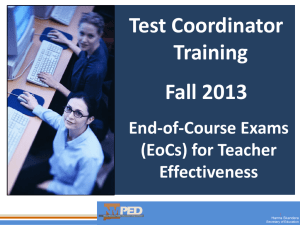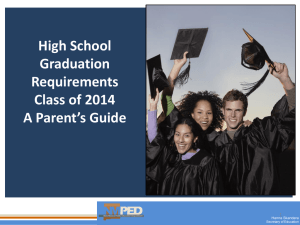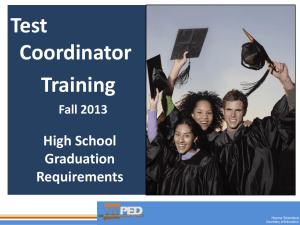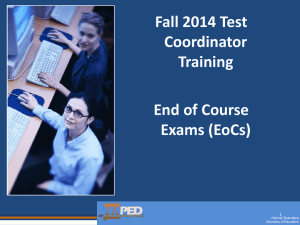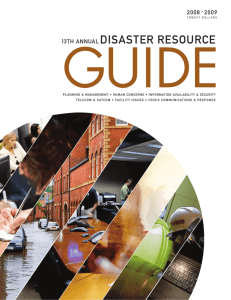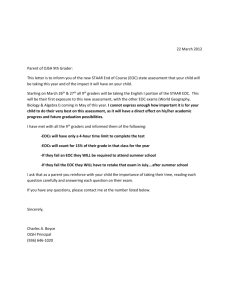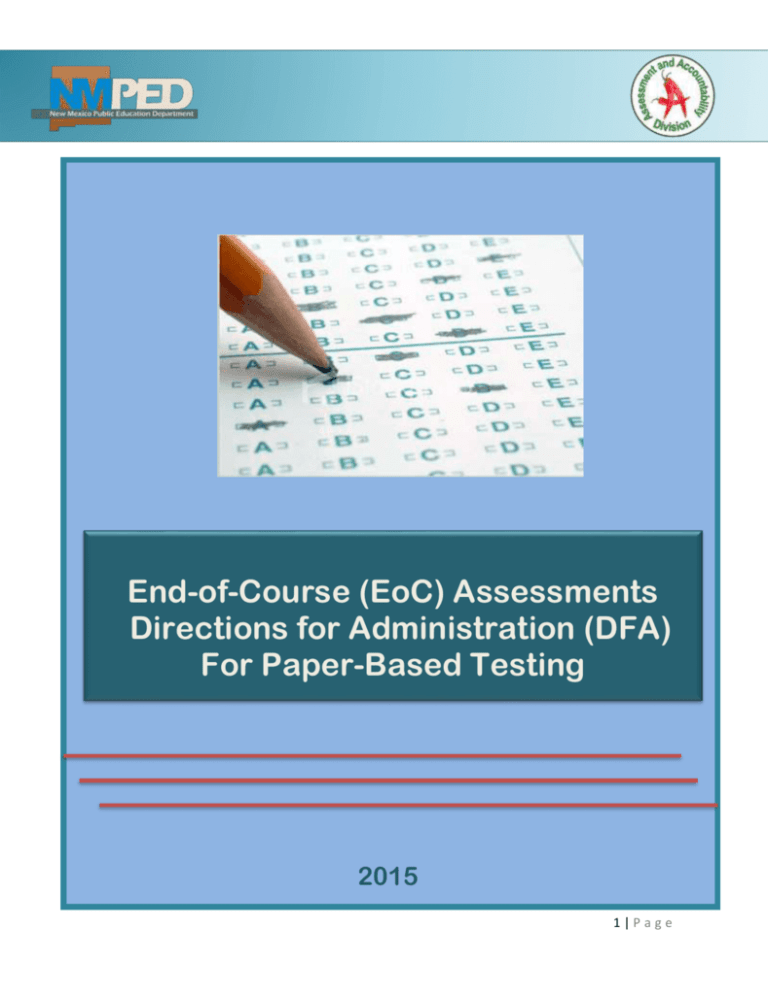
End-of-Course (EoC) Assessments
Directions for Administration (DFA)
For Paper-Based Testing
2015
1|Page
The State of New Mexico
New Mexico Statewide
Assessment Program
End-of-Course (EoC) Assessments
Directions for Administration
2015
Susana Martinez
Governor
Hanna Skandera
Secretary of Education
Developed by
New Mexico Public Education Department
Assessment and Accountability Division
300 Don Gaspar Avenue
Santa Fe, New Mexico 87501
Copyright Notice
The contents of this manual are copyrighted and the property of the New Mexico Public
Education Department (PED). All rights reserved. This publication may be reproduced for
the purpose of test administration by an authorized test administrator or coordinator of a
New Mexico public school district or charter school.
2|Page
Contents
Overview of EoCs ............................................................................................................................ 5
Purpose ....................................................................................................................................... 5
Eligibility for EoCs ........................................................................................................................ 5
PED EoCs Spring 2015 ................................................................................................................. 6
EoC Retakes ............................................................................................................................... 10
Test Windows ............................................................................................................................ 11
Administration Days and Times ................................................................................................ 11
Item Types ................................................................................................................................. 12
MC: Multiple Choice (MC) ..................................................................................................... 12
Short Answer (SA) .................................................................................................................. 12
Performance Item.................................................................................................................. 12
Unscored Performance Component...................................................................................... 13
Optional Performance Component ....................................................................................... 13
Essay ...................................................................................................................................... 13
Spanish EoCs.............................................................................................................................. 13
Before Testing ............................................................................................................................... 14
Reproducing Test Materials ...................................................................................................... 14
Preparation for Testing ............................................................................................................. 14
Testing Times ............................................................................................................................ 15
Student Reference Sheets ......................................................................................................... 15
Student Answer Documents ..................................................................................................... 15
Calculators ................................................................................................................................. 16
Scratch Paper ............................................................................................................................ 16
Accommodations and Modifications ........................................................................................ 17
Preparing the Testing Room ..................................................................................................... 17
During Testing ............................................................................................................................... 18
Test Security and Monitoring .................................................................................................... 18
Extended Time .......................................................................................................................... 19
Testing Disruptions ................................................................................................................... 19
3|Page
General Directions for Administering ....................................................................................... 20
Test Administrator (TA) Directions ........................................................................................... 21
TA’s Role During and the Test Session ...................................................................................... 22
After Testing ................................................................................................................................. 23
Test Scoring ............................................................................................................................... 23
Scoring of Constructed Response and Performance Items ................................................... 23
Performance Component Documents .................................................................................. 25
Score Reporting ......................................................................................................................... 25
4|Page
Overview of EoCs
Purpose
End-of-Course Exams (EoCs) are intended to be final exams for specific courses. They
measure student proficiency of a subset of the Common Core State Standards (CCSS) for
language arts and mathematics, and the New Mexico State Standards (NMSS) for other courses.
They are summative assessments that cover a wide range of content, skills, and applications.
Most of the assessments are fully multiple-choice (MC) while others include
performance-based components or constructed response questions. Scores are reported to the
teacher, school, district, and state levels for various purposes which may include student
grades, curriculum review, student graduation requirements, and optionally for the Educator
Effectiveness System (EES).
EoCs are available online through Blackboard or on paper. Blackboard-administered EoCs
require specific set-up as outlined in the EoCs on Blackboard Manual and DFA. Paper tests are
provided through the Student Online Assessment Prep (SOAP) portal to SOAP Managers.
Printing, distributing, scoring, maintaining, destroying, and reporting of scores for paper tests is
the responsibility of the district or school.
Eligibility for EoCs
EoCs are final exams that should be administered at the end of the course. Students may take
an EoC as long as they have completed a course for which the EoC is intended. An EoC may be
used for any approved course that aligns with the curriculum outlined in the blueprint.
Blueprints are available on the PED website at
ped.state.nm.us
>
A-Z
Directory
>
Assessment
and
Evaluation
>
EoC
(http://ped.state.nm.us/AssessmentAccountability/AssessmentEvaluation/EOC/index.html).
Teachers should access the blueprints to ensure that they are teaching the essential standards
that are assessed on the EoCs.
If a district or charter school has chosen EoCs as a Student Achievement Measure (STAM) for
use in the Educator Effectiveness System (EES), all eligible students must take the EoCs that
align to their courses.
High school students may also take EoCs in reading, writing, math, science, and social studies to
meet graduation requirements.
5|Page
PED End-of-Course Exams (EoCs) Spring 2015
PED EoCs For High School
Content Area
Reading
Writing
Mathematics
Science
1
EoC
Version
Number
Number of
Items
English III: Reading
Spanish III: Reading
English IV: Reading
English III: Writing
Spanish III: Writing
English IV: Writing
006
001
003
006
001
003
24
30
24
17
10
22
Possible
Maximum
Score
24
30
24
36
34
41
Algebra I
003
37
Algebra II
006
Integrated Math III
Mathematics ADC
Passing
Score
ADC
14
14
15
24
15
26
Y
Y
Y
Y
Y
Y
37
18
Y1
26
26
14
Y
003
003
36
32
36
32
17
16
Y
Y
Geometry
003
36
36
Y1
Pre-Calculus
004
31
31
Y
Financial Literacy
Biology
003
007
30
50
30
50
27
Y1
Y
Chemistry
008
50
49
24
Y
Physical Science
001
50
50
Y
Physics
003
50
50
Y
Environmental Science
Anatomy and Physiology
001
002
54
58
54
58
Y
Y
Supplemental
Materials
None
None
None
None
None
None
PARCC HS Math
Calculator
PARCC HS Math
Calculator
Calculator
Calculator
PARCC HS Math
Calculator
EoC-specific
Calculator
Calculator
None
PED Periodic Table
Calculator
PED Periodic Table
EoC-specific
Calculator
EoC-specific Calculator
None
None
Test Format
MC
MC
MC
MC + Essay
MC + Essay
MC + Essay
MC
MC
MC
MC
MC
MC
MC
MC
MC
MC
MC
MC
MC
Students must pass the Algebra II course to implement a passing score on the Algebra I, Geometry, or Financial Literacy EoCs for graduation.
6|Page
Content Area
Social Studies
Career Technical Education
Business/IT
EoC
U.S. History
U.S. Government
Economics
N. M. History
World History and Geography
Introduction to the Science of
Agriculture
Introduction to the Physical
Science of Agriculture
Introduction to Agricultural
Mechanics
Horticulture and Botany of Agriculture
Nutrition
Culinary Arts I
Driver’s Education
Basic Computer
General Computer Apps
Version
Number
007
005
004
004
003
PED EoCs For High School
Number of
Possible
Items
Max. Score
62
62
50
50
44
44
44
44
45
45
Passing
Score
31
24
23
18
25
Y
Y
Y
Y
Y
Supplemental
Materials
None
None
None
None
None
ADC
MC
MC
MC
MC
MC
001
60
60
N
None
MC
001
60
60
N
None
MC
001
59
59
N
None
MC
001
60
60
N
None
MC
001
003
002
001
002
34
57
50
50
47
34
57
50
50
47
N
N
N
N
N
MC
MC
MC
MC
MC
Introduction to Art 9–12
002
51
51
N
Ceramics
Digital Photography
Health
001
001
002
51
50
60
51
50
60
N
N
N
None
Calculator
None
None
None
Drawing Materials
Paper Answer Doc
Specific DFA for
Administration
None
None
None
Physical Education 9–12
002
31
39
N
Analog Clock
Spanish I
Drama
Music 9–12
003
001
002
32
62
40
32
N
N
N
None
None
None
Visual Arts
Health
Physical Education
Language
Performing
Arts
Test Format
40
32
20
MC
2 Drawings
MC
MC
MC
MC
1 Short Answer
MC
MC
MC2
2
If students attend a New Mexico Music Education Association (NMMEA) sanctioned music performance assessment (MPA), scores from those festivals will be incorporated into the educator effectiveness model for the respective teacher. If students do not attend the NMMEA MPA, only the MC portion of the EoC will apply.
7|Page
PED EoCs For Middle School
Content Area
English Language
Arts
Math
Science
Social Studies
Career Technical
Education and FACS
3
EoC Name
ELA
ELA
ELA
Math
Math
Math
Pre-Algebra
Science
Science
Science
Social Studies
Social Studies
Social Studies
Family and Consumer
Science
Exploratory Science in
Agriculture
Assessable
Grades
Version
Number
Number
of Items
6
7
8
6
7
8
6–93
6
7
8
6
7
8
003
003
003
003
003
002
003
004
001
002
002
001
001
33
30
31
25
24
30
30
36
38
46
34
42
33
Possible
Maximum
Score
33
30
31
25
24
30
30
36
38
46
34
42
33
6–8
004
42
7–8
001
45
Passing
Score
Supplemental Materials
Test Format
None
None
None
PARCC Math 6
PARCC Math 7
PARCC Math 8
PARCC Math 8
None
None
None
None
None
None
MC
MC
MC
MC
MC
MC
MC
MC
MC
MC
MC
MC
MC
42
None
MC
45
None
MC
MC
1 Drawing
5 Short Answer
Visual Arts
Art
6–8
002
21
26
Business/IT
Keyboarding
6–8
003
36
36
Still Life
Paper Answer Doc
Specific DFA for
Administration
None
Physical Education
Physical Education
6–8
002
30
34
None
Performing Arts
Music
6–8
003
30
30
None
MC
MC
2 Short Answer
MC
The Pre-Algebra EoC applies to students studying a pre-algebra curriculum in middle or high school.
8|Page
PED EoCs For Elementary School
Content Area
EoC Name
Assessable
Grades
Version
Number
Number
of Items
Visual Arts
Visual Art
4–5
002
45
Possible
Maximum
Score
45
Performing Arts
Music
4–5
002
21
27
Physical Education
Physical Education
4–5
002
21
30
Passing
Score
Supplemental Materials
None
MP3 Player
Specific DFA for
Administration
Basketball
Hand-held Ball
2 Cones
Specific DFA for
Administration
Test Format
MC
MC
1 Short Answer 1
Performance
MC
3 Activities
9|Page
EoC Retakes
Students may retake high school EoCs in reading, writing, math, science, and social studies to
meet the passing score for graduation. Other EoCs may not be retested unless the student
retakes the course. A student may NOT take the same test more than once on the same day.
For the EES, only the student’s first attempt connects with the teacher of the course, and this
connection is only made if the EoC is taken during the academic year in which the student
completed the course.
High School EoC retakes are per course. For example, student trying to meet graduation
requirements in science may take an EoC in biology twice, then an EoC in chemistry twice, then
an EoC in physics twice, etc.
For Seniors Graduating in 2015:
Content Area
Reading
Math
Science
Writing
Social Studies
Number of Retakes
1
1
1
2
2
Total Number of Attempts
2
2
2
3
3
Students in the cohorts of 2016 and beyond take PARCC for accountability and graduation.
Since PARCC includes writing, that assessment becomes the first attempt at meeting the writing
graduation competency and the writing EoC becomes only an ADC.
For Seniors Graduating in 2016 and beyond:
Content Area
Reading
Math
Science
Writing
Social Studies
Number of Retakes
1
1
1
1
2
Total Number of Attempts
2
2
2
2
3
Students on the career pathway have one additional attempt on all EoCs so that the initial
test can be used to set passing scores.
10 | P a g e
Test Windows
EoCs may be administered during the following test windows. Exceptions may be made with
an approved written request sent to Joslyn Overby at Joslyn.Overby@state.nm.us.
SEASON
Fall
Winter
Spring
Summer
ADMINISTRATION WINDOW
Two consecutive weeks during last 3 weeks of fall semester
One week during first 3 weeks of spring semester
Two consecutive weeks during last 3 weeks of spring semester
Last week of summer school course OR 6/22/15–6/26/15
Administration Days and Times
Ideally, all students in a school will complete administration of one EoC on the same day. If
that is not possible, the EoC should be administered on consecutive days in as short a period of
time as possible. Students who miss the initial administration should make up the test as
soon as possible upon returning to school.
Seniors whose school year ends earlier than other students may take EoCs in an earlier window.
They should take their EoCs as close to the end of their school year as possible to minimize
interaction with other students after test completion.
A school’s testing schedule must follow these requirements:
EoCs must be administered according to an organized schedule that may be submitted
to the PED upon request.
For security reasons, EoCs should be administered in as short a time span as possible.
Ideally, an EoC for a particular course will be administered to all students in a single day
or two consecutive days. If all students in the course cannot test in one or two days,
administration of the EoC may occur within one week, Monday through Friday.
All testing must occur during the administration windows previously listed.
Make-up days must occur within the testing windows.
Tests may be administered to typical class sizes. In some cases, this will exceed the
typical 25:1 proctor-to-student ratio. As long as TAs carefully monitor the students,
this is permissible.
Ideally, TAs will not administer EoCs to their own students or within their own content
area.
11 | P a g e
Item Types
EoCs may contain four different item types:
1)
2)
3)
4)
Multiple Choice (MC)
Short Answer (SA)
Performance Item
Essay
MC: Multiple Choice (MC)
All EoCs have MC items. The PED provides an EoC Answer Document for use in administering
these tests. Schools that have automatic scoring devices or software may use their own
answer documents.
Short Answer (SA)
The following EoCs have SA items:
Art Grades 6 – 8
Physical Education Grades 6 – 8
Physical Education Grades 9 – 12
Music Grades 4 – 5
These four tests have answer documents embedded in the test form, so students do not need
an additional answer document.
Performance Item
Performance items require that students do or create something as a part of the assessment. A
grader, usually the instructor of the course, must use the rubric to score students as they
complete the performance tasks. All of these EoCs have specific DFAs for administration, and
scoring must be conducted according to the directions in this DFA. The following EoCs have
performance items:
Art Grades 6 – 8
Music Grades 4 – 5
Physical Education 4 – 5
Note: For Art Grades 6 – 8, the teacher must set up a still life according to the directions on the
blueprint.
12 | P a g e
Unscored Performance Component
The following test requires that students complete drawings, which they will reference during
the test.
Art 9 – 12
The teacher must make drawing materials available according to the directions on the
blueprint.
Optional Performance Component
The following EoCs have OPTIONAL performance components. If students attend New Mexico
Music Education Association (NMMEA) sanctioned music festivals, scores from those festivals
will be incorporated into the educator effectiveness model for the respective teacher. If
students do not participate in music festivals, only the scores from the multiple choice portion
of the tests will be applied. In both cases, TAs and TCs do NOT have to provide any
information or scores from the music festivals. PED is working with NMMEA to obtain those
scores directly.
Music Grades 6 – 8
Music Grades 9 – 12
Essay
Essays are included in the writing tests. The EoCs that include essays are:
English Language Arts III V002
English Language Arts IV V001
Spanish Language Arts III V001
Scoring of essays must be conducted according to the directions in this DFA.
Spanish EoCs
Eligible Spanish-speaking ELs may test in Spanish. This includes ELs in their first three years in U.S.
schools, and those in their fourth and fifth years in U.S. schools with an approved waiver. Translations
of all EoCs will be available through SOAP.
13 | P a g e
Before Testing
Reproducing Test Materials
EoC test booklets, answer documents, scoring keys, and rubrics are in digital format and can be
downloaded from the PED’s secure Student Online Assessment Prep (SOAP) website at any
time. The most updated versions of the EoCs are available on SOAP. Please ensure that you
are using the most updated versions of the EoCs for each administration. After downloading,
the DTC should immediately print the EoCs and delete all local copies from the computer.
Districts/charter schools must locally reproduce test materials, and each booklet should be
inventoried with a serial number for tracking during all material transfers.
All assessments are new in Spring 2015 and should be printed and copied for administration.
Old versions should not be administered.
Districts/charter schools may use a printing service to reproduce EoC test documents. The
printing service must be made aware of the high stakes nature of the assessments, and all
individuals involved in the process must sign a confidentiality agreement. A certified staff
member from the district must be in charge of the process and is ultimately responsible for
maintaining test security.
Preparation for Testing
Inform students of the importance of the EoCs and of the testing schedule before testing begins. Be sure that students are familiar and comfortable with standardized test procedures and
test-taking strategies. Ensure that students are prepared to take tests in which they select an
answer to multiple-choice questions and, for the writing tests, write their own answers to
open-ended questions.
TAs should become familiar with all administration procedures prior to testing. Read through this
Directions for Administering (DFA) manual carefully. Reviews the testing schedules selected by
the district or charter school and gather materials for each session before the start of testing. The
TA should have a list of the students who will be testing in his/her classroom, as well as a list of
students requiring accommodations and the accommodations each student requires.
Prepare the testing room by ensuring that the space has the following:
•
adequate lighting and space between students’ desks
•
a “Testing—Do Not Disturb” sign on the door
•
nothing visible that would give clues to any of the answers on a test, such as rubrics,
writing guides, word walls, hundreds charts, fact tables, or other course-related material.
14 | P a g e
Testing Times
Tests were produced to fit into the following test administration times. This time includes
starting and stopping the test and should guide scheduling of assessments.
Session
Recommended Session Time
High School Assessments
90 minutes
Middle and Elementary School Assessments
60 minutes
Student Reference Sheets
The following EoCs have reference sheets. The tests have the reference sheets embedded,
and additional reference sheets may be provided to students if necessary. The reference
sheets are NOT secure and may be retained for use in instruction.
Pre-algebra
Algebra I
Geometry
Algebra II
Pre-calculus
Math 6
Math 7
Math 8
Chemistry
Physics
Physical Science
Student Answer Documents
Assessments with written components (short answer and essay) have answer documents embedded in the test. For other assessments, the TA must supply an answer document. Students may use the PED EoC Answer Document for the MC portion, or they may use a district or
school-provided answer form.
15 | P a g e
Calculators
Students may use calculators on the following EoCs:
4-function Calculator with Square Root and Percent Functions:
Math 6
Math 7
Math 8
Scientific or Graphing Calculator
Pre-algebra
Algebra I
Geometry
Algebra II
Pre-calculus
Financial Literacy
Integrated Math III
Math ADC
Culinary Arts I
Chemistry
Physics
Physical Science
Note: Calculators may not have a QWERTY keyboard, an attached electronic pen, a printing attachment, ability to communicate wirelessly with other devices, distracting sound effects, a
raised screen, or an attached cord. Graphing and scientific calculators are allowed for the
specified assessments. All programs in graphing calculators must be cleared before the assessment begins. All information on the screen or in the memory of calculators must be
cleared after the assessment.
Scratch Paper
Students may use scratch paper on all EoCs. Graph paper may be used on math and science
EoCs, if desired. At the completion of testing, scratch paper must be collected by the TA and
returned to the STC or DTC for proper disposal. The STC or DTC must secure the scratch paper
in a locked space until it is destroyed. Shredding is the recommended method for destroying
scratch paper.
Each school must form a method for TA distribution and collection of scratch paper. It is
ultimately the responsibility of the STC and DTC to ensure that scratch paper is properly
destroyed.
16 | P a g e
Accommodations and Modifications
Some students have one of the following:
Student Assistance Team (SAT) Intervention Plan
Individualized Education Program (IEP)
Section 504 Accommodations Plan
English Language Leaner (ELL) Plan
Accommodations decisions will be made by the student’s applicable educational team. The
team should have ensured the student received the agreed-upon, allowable accommodation(s)
for instruction and assessment in the content area for a sufficient amount of time prior to the
EoC administration so that the student will be comfortable with using it on the test. The use of
each accommodation in daily instruction must have written documentation (in the SAT, IEP,
504 or ELL plan). Only students on SAT, IEP, 504, or ELL plans are eligible for accommodations.
See a complete list of allowed accommodations in the Student Assessment Accommodations
Manual
on
the
website
http://www.ped.state.nm.us/AssessmentAccountability/AssessmentEvaluation/index.html.
Be sure to maintain records of all students who obtain accommodations on EoCs.
Prohibited modifications are changes in test administration that interfere with the
comparability of scores. Examples of modifications include use of a spelling- or
grammar-checking tool on the writing test or use of a calculator on tests in which calculators
are not permissible. Non-allowable modifications are strictly prohibited on the EoCs. Any test
in which non-allowable modifications are provided must be invalidated.
Preparing the Testing Room
Before administration: Be sure to remove or cover up any visible classroom materials used in
the instruction of the course such as word walls, posters, charts, graphs, mathematical tables,
etc. Prepare materials such as scratch paper, calculators, reference sheets, and other classroom
materials as needed for specific tests. Gather and set up materials for all tests that require performance components.
17 | P a g e
During Testing
Test Security and Monitoring
Test materials must be kept secure to ensure that EoCs accurately measure student
achievement. If anyone gains an unfair advantage through a security breach, it might result in
invalidation of test scores. The guidelines below are provided to safeguard against a security
breach.
Teachers may not access EoC test booklets or scoring keys before, during, or after test
administration. The MC portion of all EoCs should be handled and scored by someone other
than the teacher of the course.
Test administrators (TAs) must follow these security guidelines before, during, and after testing:
Remove or cover any relevant classroom materials used in the instruction of the
course such as word walls, posters, charts, graphs, mathematical tables, etc.
Receive training on test security and administration by the School Test Coordinator
(STC) or the District Test Coordinator (DTC).
Complete the New Mexico Public Education Department (PED) Confidentiality
Agreement and return it to the STC. The Confidentiality Agreement form is available on
the Assessment and Evaluation page on the PED website.
Closely monitor students during testing to ensure that proper testing procedures are
being followed. In particular, look for signs of cheating and any use of electronic
devices by students.
Ensure that test materials are stored in a central, locked, monitored area when not in
use.
Ensure that computer systems used for administering tests are disabled from access to
search engines, email, social networks, cloud folders, and other means of information
sharing during testing.
Follow the testing schedule established by your district/school.
Ensure that no TA or proctor is assigned to a classroom in which a relative is being
tested.
Report to the STC any possible breaches of security immediately.
18 | P a g e
Examples of security breaches include, but are not limited to, the following:
-
improper handling of test materials, such as
someone keeping or reproducing any test materials or student responses
allowing any unauthorized access (by students or staff) to test materials
before, during, or after testing
leaving test materials unsecured when the TA or a proctor is not in the
classroom
-
improper test administration procedures, such as
coaching students during testing
altering student responses in any way
School and district staff members are prohibited from studying or discussing test
questions in any manner, either among themselves or with students, before, during, or
after testing.
Teachers may not view the EoCs or MC scoring keys before, during, or after testing.
Scoring must be conducted by school staff members who do not teach the courses or
students being tested.
Testing irregularities must be immediately reported to the School Test Coordinator (STC). The
STC should report to the DTC, and the DTC should contact the PED as soon as possible with
details regarding the irregularity. For each incident, the DTC must submit a Testing
Irregularity Form to the PED.
Extended Time
EoCs are untimed tests, so students may receive extended time. High school tests were written
to take the average student about 60–75 minutes, and middle/elementary tests were written
to take the average student about 45 minutes. However, all students who need extra time may
have it, even if they do not have the extended time accommodation indicated on an IEP.
Testing Disruptions
If an emergency such as a fire drill or emergency evacuation occurs during testing, students
should be kept from discussing the test until they return to the testing room and complete the
assessment. Upon their return, students may continue testing but my not change previously
completed answers.
19 | P a g e
General Directions for Administering
The Test Administrator (TA) must be a certified staff member who has received training from
the DTC or STC. In the event that schools require additional staff to administer the EoCs, school
aides (who have received training) may be used to provide one-on-one accommodations.
Students may not have cell phones in their possession during any testing session. If a student
is caught with a phone during testing, the phone must be confiscated and provided to the
School Test Coordinator. Administrators must conduct an investigation to ensure that the
student did not violate test security by using the phone, and must provide a testing irregularity
form to the PED.
Districts may administer and score EoCs on computers if they can implement the assessments
on a secured system. The secure system must lock down all computer capabilities to include
disabling access to search engines, email, social networks, cloud folders, and other means of
information sharing.
20 | P a g e
Test Administrator (TA) Directions
The following directions that are to be read aloud are in bold print. Directions to the TA,
interspersed within the script, are in regular print and in brackets. Read the directions for
students exactly as written, using a natural tone and manner. The TA may not help students
with specific test questions. If you make a mistake in reading directions, stop and say, No. That is
wrong. Listen again. Then reread the direction.
• Encourage the students to do their best.
• Check periodically to make sure that the students are
recording their answers properly and,
working until they reach the end of the test or testing session.
• Remember that you are prohibited from spelling words for students on the writing EoCs and
any constructed response items.
Script to Be Read to All Students at the Start of Testing
SAY
Cell phones and other electronic devices are not allowed in the testing
rooms. If you have a cell phone in your possession, turn it off and place it in
your backpack for testing.
[Wait for students to secure their cell phones. Follow your local policy for managing
cell phones during testing.]
SAY
Use a #2 pencil to record answers on your answer document.
SAY
On your Answer Document, fill in your Name (First and Last Name),
Student ID Number, Teacher’s Name, and Today’s Date (MM/DD/YYYY)
SAY
You have __ minutes to complete this test. [Recommended times are 60
minutes for ES and MS, 90 minutes for HS.] You may have extra time if necessary.
SAY
Read each question carefully. Select the CORRECT answer from the options provided.
SAY
You may write in your test booklet. If you need to change your answer to a
question, be sure to erase completely before marking or writing your new
answer. Testing materials may not be taken out of the testing room for any
reason.
SAY
If you finish your test early, you may read a book. No other activities are
allowed.
SAY
No talking is allowed during test administration. You may now begin.
21 | P a g e
TA’s Role During and the Test Session
Remain attentive in the room during the entire testing session.
Circulate throughout the room during the testing session. Reading, grading papers, or
doing other work is prohibited.
Remember that identifying and pointing out questions a student did not complete
either during or after the test is not allowed.
Remind students as part of the general instructions to complete all of the questions and
to check to be sure they have completed this test.
Collect the test booklets and answer documents from the students as they finish. Direct
the students to sit quietly at their desks or quietly read a book.
Once testing is complete, collect all test materials and return to the Test Coordinator for
secure storage.
Immediately report any testing irregularities to the STC.
22 | P a g e
After Testing
Test Scoring
All multiple choice questions should be scored electronically, if possible. If not possible, they
must be scored by someone other than the teacher of the course. For short answer and extended response items and all performances, a subset of student responses must be scored by
two scorers. The scorers must be knowledgeable in the field and may be teachers, administrators, or professionals. The primary scorer must be a certified teacher with the proper content area endorsements, and may be the teacher of the course.
Scoring of Constructed Response and Performance Items
For scoring of short answer and extended response written answers, scorers must follow
these guidelines:
Responses should be scored after students complete the written portion of the assessment.
The two scorers collaboratively review the scoring rubrics before scoring begins.
Each scorer independently scores student A.
The two scorers compare scores for student A. If the scores are the same, the scorers
move on to student B.
If the scores are different, the two scorers discuss why they scored the way they did
and agree upon a score based on the rubric. After agreeing upon the score, the scorers move on to student B.
The two scorers continue this practice for the first 25 students. If the two scorers are
scoring uniformly at that point, the primary scorer may continue scoring independently.
If the two scorers are not scoring uniformly after 25 students, they should continue this
process until they repeatedly score uniformly.
After completing this process on day 1, two scorers are only required for the first 10
students on each subsequent day of scoring.
For scoring of the performances, the first 10 students must be double-scored on the first day of
testing and on additional days such that double-scoring occurs on half of the testing days.
This means that, for half of the days in which the test is given, the first 10 students must be
scored by two people according to the following guidelines. For an odd number of testing
days, you may round down for the double-scoring requirement. For example, if a TA administers the assessment on all five days of a school week, double-scoring must happen on Monday
23 | P a g e
and one other day during the week. The purpose of double-scoring is to promote consistent
application of the rubric and ensure inter-rater reliability.
The two scorers collaboratively review the performance rubric before administering this
portion of the EoC.
The performances should be scored while students perform according to the performance rubric.
While the first ten students perform, the scorers independently score each student on
their rubric.
After the first ten students perform, the students may take a short break while the
scorers discuss their scores. The two scorers must agree upon a score for each component of the rubric with regard to each student. The scorers may NOT average their
scores. This discussion is intended to calibrate the primary scorer so that s/he is consistent with scoring throughout the process.
Alternately, a short discussion to calibrate scores may occur after each student performs.
After the scoring discussion, both rubrics for a student should reflect the same scores.
Both rubrics should be returned to the DTC for storage.
If the assessment is given to ALL students in ONE day, at least the first 25 students must
be double-scored. If there are fewer than 25 students, all students must be double-scored.
All secure test materials, including used, unused, and damaged test booklets, scoring keys and
rubrics and digital versions of test booklets, answer documents, scoring keys and rubrics should
be destroyed using stringent security measures within one week after scoring, or maintained in
a secure location for future use. Student answer documents should be stored in a secure
central location for a period of two years, according to 1.20.2.204 NMAC—Records Retention
Act—regarding retention of examination and testing papers.
24 | P a g e
Performance Component Documents
Prior to administering the EoC, the teacher and Test Administrator (TA) should review the following unsecure Assessment Blueprint. EoC Blueprints are available on the PED Assessment
website.
Immediately prior to administering the EoC, the secure Directions for Administration (DFA)
must be given to the TA by the Test Coordinator. All of these documents must be returned to
the Test Coordinator following the test administration. The DFA provides specific protocol for
administration of the assessment including the script to be read to students and any scoring
rubrics that must be used during a student performance.
Score Reporting
After tests are scored, the overall test scores must be reported in STARS. For spring 2015, these
scores must be input during the EOY STARS snapshot. Note: item data does NOT have to be
reported to PED in Spring 2015.
For Assistance:
Questions about…
Contact
Email Address
EoC Administration
Procedures
Severo Martinez
Severo.Martinez@state.nm.us
EoC Test Schedules
Joslyn Overby
Joslyn.Overby@state.nm.us
Accommodations
Dottie Arnao
Dottie.Arnao@state.nm.us
25 | P a g e

